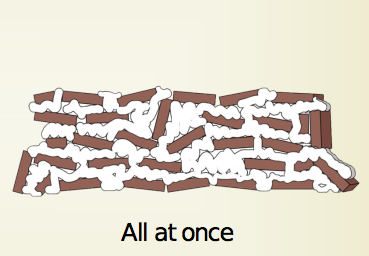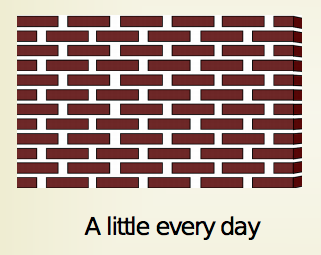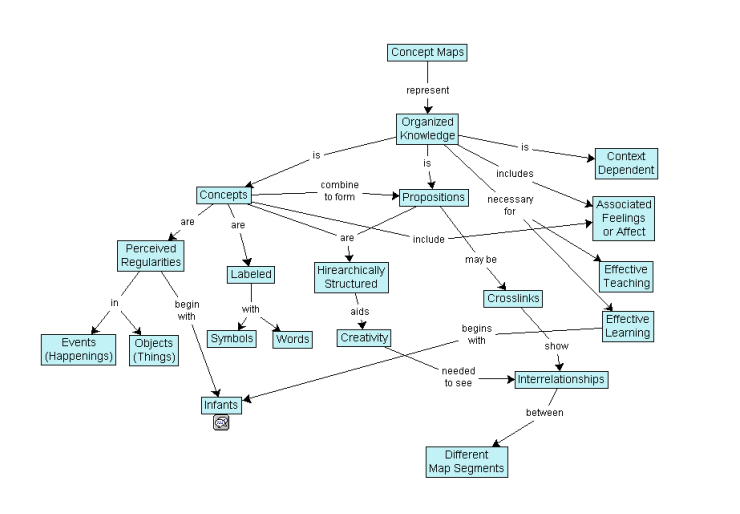This Blog is a note for the course on Coursera – Learning How to Learn: Powerful mental tools to help you master tough subjects. The transcript file is also helpful.
Week 1
There are two different learning modes: Focused Mode and Diffused Mode. When learning something difficult and new, we need to go back and forth between these two modes, and this will greatly help us learn effectively.
Procastination.
Usually, our brain feels the pain of doing one thing and try to switch to something more pleasant. The result is you will be happier, temporarily. Research has shown that not long after you start doing what you don’t like, the discomfort would disappear. One tool to help you get started is the Pomodoro – 25 minutes tool.
Practice makes permanent.
The first time we begin to understand something, the neural pattern is very weak. Then we solve this problem again from the start, we could enhance such neural pattern. Later, after the problem has been cold, we go over all the steps again withough looking at the solution and do related problems, then the pattern will be further enhanced. If procrastination comes out, use Pomodoro. Use brief periods of focused attention to help build neural patterns.
For example, after understanding the solution of one MATH 8651 problem, try it from the fresh start without reference to the solution. Then, maybe go out for a walk, after which go over the problem again.
Memory.
Working memory and long term memory.
Use the technique spaced repitition to move working memory to long-term memory.
 |  |
Relative websites: BrainFacts
Week 2
Chunk
Chunking helps the brain to learn efficiently. Once we chunk an idea, we don’t need to remember all the details. We’ve got the main idea and that is enough.
- Chunks are built little by little. When learning new math material, it would help a lot to start with examples with worked out solutions. It’s like first listening to a song before starting to play it. Our job is to understand why the steps are taken the way they are. One thing we need to pay attention to is: it is easy for us to focus too much on one particular step, but do not do that. Instead, focus on the connection between steps.
How to form a chunk? Detailed Notes
- Focus your undivided attention on the information you want to chunk.
- Understand the basic idea you’re trying to chunk.
- We could chunk an idea that we don’t understand, but that chunk is often a useless one that we could not fit in later.
- Understanding how a problem was solved doesn’t mean you have created a chunk that you could easily call to mind later. That partly explains why you understand an idea in class, but if you don’t review it fairly soon, it can seem imcomprehensible when you prepare for the test.
- In math and science related subjects, close the book and test yourself whether you can solve the problem you think you understand. This would speed up your learning at this stage. You see and understand one point, but this doesn’t mean you can do it yourself. The first time you understand something is when you can actually do it yourself. Only doing it yourself helps create the neural patterns that underlie true mastery.
- Gaining context.

- Context means going beyond the initial problem and seeing more broadly, repeating and practicing with both related and unrelated problems, so that you know when to use the chunk and when not to use it. Chunk is like a tool, and we not only need to know how to use it, but also when to use it.
- Chunking may involve your learning how to use a certain problem-solving technique. Context means learning when to use that technique instead of some other technique.
- Doing a rapid two-minute picture walk through a chapter in a book before you begin studying it, glancing at pictures and section headings, can allow you to gain a sense of the big picture. Once you get the big picture, fill in the details.
Illusions of Competence
- Reread? Recall and practice!
- Reread is just a repetition. Recalling and practicing would help you get a deeper understanding and learn more, and also helps to build chunks.

- Drawing the concept map, showing the relationships between concepts turns out to be the best way to learn. But one important thing is we need to first make sure the basic concepts are embedded in the brain before trying to make connections. Otherwise, it doesn’t work.

- Reread is just a repetition. Recalling and practicing would help you get a deeper understanding and learn more, and also helps to build chunks.
- Merely glancing at the solutions? Highlighting or underlining? You need to have the information persisting in your brain!
- Merely glancing at a solution and thinking you truly know it is one of the most common illusions of competence in learning. Only by doing it yourself could you truly master the material well.
- Highlighting and underlining must be done carefully. Making lots of motions with your hand can fool you into thinking you’ve placed the concept in your brain. Try to understand the main idea before highlighting and keep the highlighting marks to the minimum.
- Test yourself instead of rereading your notes or books. Super helpful!
- Recalling concepts outside your usual study place.
